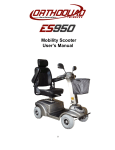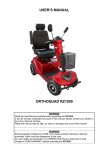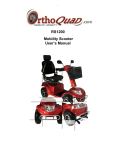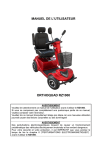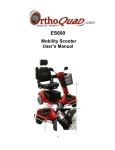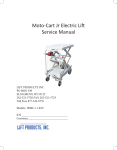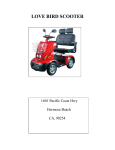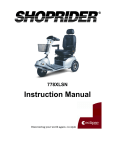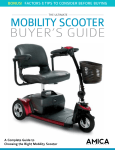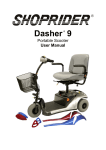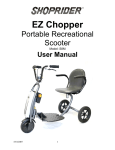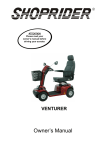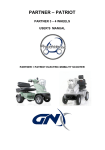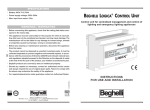Download Jupiter Scooter
Transcript
Mobility Scooter User’s Manual READ THIS USER’S MANUAL CAREFULLY BEFORE USING THIS MOBILITY DEVICE. IMPORTED BY: DISTRIBUTIONS GNX INC. HEALTH CANADA MEDICAL DEVICE ESTABLISHMENT LICENCE HOLDER - NUMBER : 4128 TABLE OF CONTENTS I. Introduction 2 II. Specifications 3 III. Features 4 IV. Operating Your Scooter 5 V. Safety Instructions 6 VI. Battery Charging 10 VII. Maintenance Schedule 11 VIII. Warranty 12 IX. Basic Troubleshooting 13 X. Storage Instructions 14 1 I. INTRODUCTION We are glad to provide you our innovations of mobility scooters: the RS1400 scooter. This type is new mobility assistive devices designed for anyone who needs an easy and quiet mode of transportation. We designed the scooters to provide personal freedom, as well as convenience and comfort, also to ensure the high performance and long life of service. This manual contains important information concerning the proper maintenance and safe operation of your scooter. Please read this manual thoroughly and carefully to become familiar with all operation instructions prior to operating your RS1400. If you have any questions concerning the operation or maintenance, please contact your dealer. Your RS1400 has many unique features not found on other scooters. With proper care and maintenance, you should enjoy many years of dependable service from your unit. Your RS1400 should receive regular maintenance according to the schedule outlined in this manual, and the recommendation from the authorized dealer. By following the maintenance instructions, you will be able to take care of most of your unit’s needs. If you are unable to correct a fault in your scooter, contact your dealer for professional checking. 2 ABOUT THE MANUAL The manufacturer reserves the rights of final interpretation on the manual. For any printing mistakes or new improvements, the manufacturer will update in the new editions. II. SPECIFICATIONS PERFORMANCE DATA Maximum forward speed Maximum backward speed Maximum Climbing Grade Ground clearance Turning radius Load Capacity (max) Range with Full Charge Braking distance 18 km/h 5 km/h 15 degrees 8cm 1.5m 180kg (400 pounds) Up to 30 - 40 km 1.8m BATTERY Sealed battery x 2 pcs 12V/75Ah – Group 24 BATTERY CHARGER Input 110V/240VAC Output 24V DC / 5amp MOTOR POWER 1400W BRAKING TYPE Regenerative braking SPEED ADJUSTMENT Stepless speed system OVERALL DIMENSIONS Length: 63’’ Width: 27’’ 3 III. FEATURES Swing away armrests Swivel seat, fully reclining Adjustable Forward/Reverse Seat Adjustable tiller Dynamic regenerative braking Rear wheel direct drive with differential Fully solid state controller External Battery Charger 24-volt permanent magnet heavy duty DC motor ON/OFF switch lock Horn Head light Turning lights Rear lights Battery charge indicator Anti-tip safety wheels Front luggage basket Front and rear bumpers Electronic Brake Release Electronic High/Low speed switch 4 IV. OPERATING YOUR RS1400 1. TURN POWER ON Insert the key into the key switch on the upper tiller and turn on the power. 2. FORWARD MOTION To move forward, pull the right side of the throttle lever under the control console toward you. The further you pull, the faster the scooter will go. The maximum speed may be selected by the speed selection switch located on the top of the control console. 3. REVERSE MOTION To reverse, pull the left side of the throttle lever under the control console toward you. Reverse speed is limited to 4.8 km/h. 4. STOP To stop the scooter, just release the throttle lever. The RS1400 will quietly come to a smooth stop and electromechanical brake will automatically engage to hold the scooter in position on horizontal surface or an incline of up to 15 degrees. Quick smooth stops are made possible by the dynamic braking built in the controller. Warning: The brake may not be as effective when engaged on inclines greater than 15 degrees or 21% if the occupant’s weight exceeds 400 pounds. In case the brake fails to engage, the RS1400 may roll slowly on a slope. Turn off the power immediately. DRIVING TEST 1). Insert the power key into the key switch and switch on. 2). Check the battery charge indicator to make sure the batteries are fully charged. 3). Make sure that manual freewheel lever is at close position. 4). Set the speed limit by turning the dial knob on the top of the console. Set Hi/ Low switch to Low position. 5). Test the scooter by moving forward, stop, and backward a couple of times to make sure that your scooter is in proper working condition. 5 5. MOVE MANUALLY – MANUAL FREEWHEEL LEVERS Whenever you want to push your RS1400 for a short distances, you can put it in manual freewheel mode. The manual freewheel lever is located on the end of the motor at the rear of the RS1400. Pull up the manual lever to disable the drive system and the brake system, your will be able to push your RS1400. Or you can press the PUSH button located on dashboard to release the brake. Take your finger off the PUSH button, and the brake will re-engage. Push down the manual freewheel lever to reengage the drive system and the brake system and take your RS1400 out of freewheel mode. Clutch = Manual lever V. SAFETY INSTRUCTIONS The following guidelines are intended to assist you in the safe operation of your RS1400 scooter. If you have any questions about the correct operation of your scooter, please contact your authorized dealer. Consult your physician if in doubt of your ability to operate the scooter. Your scooter can negotiate grass, gravel, dirt, and sand surfaces, as well as hard paved or carpeted surfaces. However, extra caution should be taken when operating your unit on uneven surfaces. There are some concerns about electromagnetic interference to powered wheelchairs and scooters. You need to know what EMI (Electromagnetic Interference) is and how to prevent such incidents. The following paragraphs suggested by the FDA are intended to provide you some important information about this. 6 CAUTION: IT IS VERY IMPORTANT THAT YOU READ THIS INFORMATION REGARDING THE POSSIBLE EFFECTS OF ELECTROMAGNETIC INTERFERENCE ON YOUR POWERED SCOOTER. Electromagnetic Interference (EMI) From Radio Wave Sources Powered wheelchairs and motorized scooters (in this text, both will be referred to as powered wheelchairs) may be susceptible to electromagnetic interference (EMI), which is interfering electromagnetic energy (EM) emitted from sources such as radio stations, TV stations, amateur radio (HAM) transmitters, two-way radios, and cellular phones. The interference (from radio wave sources) can cause the powered wheelchair to release its brakes, move by itself, or move in unintended directions. It can also permanently damage the powered wheelchair’s control system. The intensity of the interfering EM energy can be measured in volts per meter (v/m). Each powered wheelchair can resist EMI up to certain intensity. This is called its “immunity lever.” The higher the immunity level is, the greater the protection. At this time, current technology is capable of achieving at least a 20-v/m immunity level, which would provide useful protection from the more common sources of radiated EMI. The immunity level of this powered scooter as shipped, with no further modification, is not known. There are ample sources of relatively intense electromagnetic fields in the everyday environment. Some of these sources are obvious and easy to avoid. Others are not apparent and exposure is unavoidable. However, we believe that by following the warnings listed below, your risk to EMI will be minimized. The sources of radiated EMI can be broadly classified into three types: 1) Hand-held portable transceivers (transmitters-receivers) with the antenna mounted directly on the transmitting unit. Examples include: citizens band (CB) radios, “walkie talkie,” security, fire, and police transceivers, cellular telephones, and other personal communication devices. **Note: Some cellular telephones and similar devices transmit signals while they are ON, even when not being used. 2) Medium-range mobile transceivers, such as those used in police cars, fire trucks, ambulances, and taxis. These usually have the antenna mounted on the outside of the vehicle; and 3) Long-range transmitters and transceivers, such as commercial broadcast transmitters (radio and TV broadcast antenna towers) and amateur (HAM) radios. 7 Note: Other types of hand-held devices, such as cordless phones, laptop computers, AM/FM radios, TV sets, CD players, and cassette players, and small appliances, such as electric shavers and hair dryers, so far as we know, are not likely to cause EMI problems to your powered wheelchair. Powered Scooter Electromagnetic Interference (EMI) Because EM energy rapidly becomes more intense as one move closer to the transmitting antenna (source), the EM fields from Hand-held radio wave sources (transceivers) are of special concern. It is possible to unintentionally bring high levels of EM energy very close to the powered scooter’s control system while using these devices. This can affect powered scooter movement and braking. Therefore, the warnings listed below are recommended to prevent possible interference with the control system of the powered scooter. WARNINGS Electromagnetic interference (EMI) from sources such as radio and TV stations, amateur radio (HAM) transmitters, two-way radios, and cellular phones can affect powered scooter and motorized scooters. Following the warnings listed below should reduce the chance of unintended brake release or powered scooter movement, which could result in serious injury. 1) Do not operate hand-held transceivers (transmitters-receivers), such as citizens band (CB) radios, or turn ON personal communication devices, such as cellular phones, while the powered scooter is turned ON. 2) Be aware of nearby transmitters, such as radio or TV stations, and try to avoid coming close to them; 3) If unintended movement or brake release occurs, turn the powered scooter OFF as soon as it is safe. 4) Be aware that adding accessories or components, or modifying the powered scooter, may make it more susceptible to EMI (Note: There is no easy way to evaluate their effect on the overall immunity of the powered scooter. 5) Report all incidents of unintended movement or brake release to the powered scooter manufacturer, and note whether there is a source of EMI nearby. If unintended motion or brake release occurs, turn the power OFF as soon as it is safe. The following warning label is attached to your scooter in order to make users always aware that a possibility of electromagnetic interference exists. 8 In summary, - DO NOT try to climb sharp curbs. - DO NOT drive off or over obstacles exceeding 5 cm height. - DO NOT make abrupt changes in direction at high speed or while traveling on an incline. - DO NOT attempt to make fast turn on flat surfaces. - DO NOT climb inclines greater than 15 degrees. - DO NOT back your scooter on uneven surfaces or inclines. - DO NOT attempt to operate your unit in a stalled condition, such as traveling up very steep incline. This may cause the circuit break or thermal cut out, rendering your unit temporarily immobile. - DO NOT travel on highways and freeways; ALWAYS stay in the bike lanes, sidewalks and pedestrian area. - DO NOT carry passengers in any manner. - DO NOT operate your unit when the red battery indicator light is flashing. - DO NOT operate your unit with the clutch lever in the disengaging position. - ALWAYS make sure that the steering tiller adjustment lever is locked. - ALWAYS make sure that the seat is locked so that it will not swing during operation. - DO NOT turn ON or use hand-held personal communication devices, such as citizens band (CB) radios and cellular phones, while your scooter is turned ON. - BE AWARE of nearby transmitters, such as radio or TV stations and hand-held or mobile two-way radios, and try to avoid coming close to them. - BE AWARE that adding accessories or components, or modifying your scooter may make it more susceptible to interference from radio wave sources. 9 VI. BATTERY CHARGING To ensure the best performance and maximum battery life, we recommend frequent battery charging. Your RS1400 comes with an external battery charger for your ease and convenience. The console battery display makes charging simple and easy. It is recommended that you charge your scooter every night. Follow these steps for battery charging. 1). The console battery level display has red lights; each indicates 10% of battery charge. This acts like an automobile fuel gauge. 2). On a level, dry surface, turn off the power key and plug the extension cord into the charger socket located on the steering console. Then plug the other end of the charger cord into a wall outlet. 3). Charge the battery for 8-14 hours depending on the usage before charging. Disconnect the charger from the wall outlet, disconnect the extension cord from the scooter, insert key into tiller and check if all gauge lights are on. 4). There is no possible way to overcharge the battery as the charging voltage is set constant. In general, you may start charging before you go to bed at night and disconnect it in the next morning. Battery Charger Hook up 10 VII. MAINTENANCE SCHEDULE In order to obtain the best performance and lasting service life, please maintain your unit according to the following schedule and instructions: DAILY Check brake effectiveness before you drive. Recharge batteries fully every night. WEEKLY 1.Check tire pressure. The pressure should be 40-45 psi. 2. Clean seat upholstery, plastic body and covers. To avoid the electrical failure, do not spray water directly to your unit. 3. Use a damp clean rag to clean all parts. 4. Check and tighten the throttle lever attached screws. MONTHLY 1. Check battery condition. Clean terminals if necessary. 2. Check all electrical wire connectors to eliminate loose connection. 3. Tighten all exposed bolts and nuts. 4. Check wheel bearings by spinning tires and checking for free rotation. YEARLY Visit your dealer and let technician check your scooter completely. 11 VIII WARRANTY To guarantee your benefits and the excellent after-sale service provided by the manufacturer, please read the following items carefully. I) GUARANTEE CONTENTS, TARGETS AND DEADLINE: 1. guarantee contents: Purchase the unit from the manufacturer or authorized dealer. Operate according to the instructions set in this manual. The manufacturer guarantee to any quality problems concerns its manufacturing or materials within the guarantee period. 2. Guarantee target and deadline: from the date of purchase (1) The motor and gearbox is guaranteed to replace or to repair within a 2 year. (2) The battery is guaranteed 6 months after the date of purchase by the end-user.(customer) (3) All other RS1400 components are guaranteed for 1 full year after the date of purchase by the end-user.(customer) II) GUARANTEE IS NOT ENSURED WITH THE PROBLEMS CAUSED BY THE FOLLOWING: (1) Do not operate according to the manual. (2) Do not get maintenance from the specified dealers. (3) Do not use the components or parts made by our corporation. (4) Modify the unit or its part without authorization.. (5) The warranty has expired. (6) Incidents caused by uncontrollable factors such as typhoon, floods, fire, earthquake or war. 12 IX. Basic Troubleshooting 1- All of my RS1400 systems appear to be ¨dead¨ Possible solutions Ensure the key is fully inserted and turned on. Ensure the batteries are fully charged. Ensure both battery harnesses are firmly connected to the electronic controller module and to the battery terminals. 2- My RS1400 battery indicator shows a full charge, but my scooter does not move when I push the throttle. Possible solutions Ensure your RS1400 was not left in freewheel mode. (Push on the freewheel lever to restore normal operation.) NOTE: When the freewheel lever is pulled up, your RS1400 brakes are disengaged and all power to transaxle is cut. IF YOU EXPERIENCE ANY PROBLEMS WITH YOUR RS1400 THAT YOU ARE NOT ABLE TO RESOLVE, IMMEDIATELY CONTACT YOUR AUTHORIZED ORTHOQUAD DEALER FOR INFORMATION, MAINTENANCE AND SERVICE. 13 X. STORAGE INSTRUCTIONS Always store in a dry area protected from freezing to avoid damage to the scooter and premature wear of the batteries. Avoid exposure to rain, snow, ice, salt or stagnant water. Keep your scooter clean and dry. Never expose the electronic components of the scooter to humidity (rain, snow, mist, or water from washing), as it may damage electronic circuits. Always store your scooter with batteries fully charged. When storing the scooter for more than two weeks, charge the batteries and disconnect them. During the storage, check the charge once a month and recharge the batteries as needed. You must complete a full charge cycle every month or damage to batteries can occur. Avoid extreme temperature of hot and cold during storage. Freezing can damage low charged batteries and they may become unusable. IMPORTED BY: DISTRIBUTIONS GNX INC. HEALTH CANADA MEDICAL DEVICE ESTABLISHMENT LICENCE HOLDER - NUMBER : 4128 14















